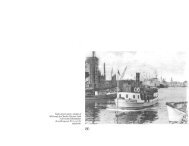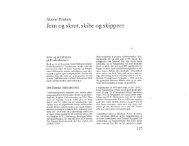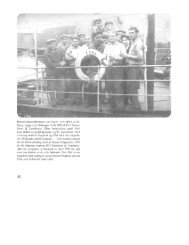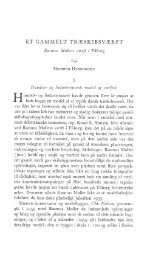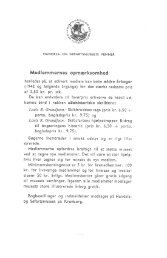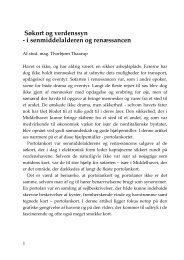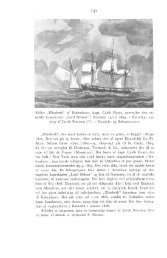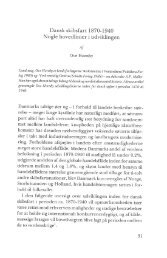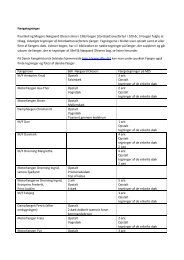Henning Henningsen: Rejs ud til Vagt! - Handels- og Søfartsmuseet
Henning Henningsen: Rejs ud til Vagt! - Handels- og Søfartsmuseet
Henning Henningsen: Rejs ud til Vagt! - Handels- og Søfartsmuseet
You also want an ePaper? Increase the reach of your titles
YUMPU automatically turns print PDFs into web optimized ePapers that Google loves.
The leader of the watch is called the quarter-master, which could indicate that<br />
originally there were 4 watch teams (quarter watches). It seems, however, that the<br />
French quart, quartier, which was taken over by most languages, had nothing to do<br />
with quart = four (Latin quartus) but was a phonetic misunderstanding of Spanish<br />
guardia, meaning watch (cf. English ward). About 1370 quarteniers are mentioned in the<br />
French Navy, and in 1443 quarter maisters in the English Navy. Their insignia and<br />
mark of command were the boatswain's whistle or call (French sifflet). One such<br />
whistle is reported ona French ship from 1250, and in 1418 a whistle is mentioned on<br />
an English ship. One must remember, however, that the dates we come across are<br />
purely arbitrary and in no way indicate that the objects or persons concerned appear<br />
for the first time. When we find a mention of these indicators in an old text it is a sign<br />
that the watch-system has been introduced on board - and this also applies to the<br />
traverse board which was used to record course and speed during the watch.<br />
The watch-system itself became a necessity during the Middle Ages because as<br />
time went by ships got bigger and bigger, which in turn meant that the size ofthe<br />
crew also increased, especially on warships. The structure ofthe crew changed and<br />
there arose a need for many different specialists on board. The system also entailed<br />
tighter discipline, and individual liberty was restricted. Democracy was on the wane<br />
while the captain and officers got more power.<br />
Naturally the watch-system did not arise out of the blue. It had its origins in<br />
systems used on board ships in earlier times, primarily the night-watch, which again<br />
was based on ancient military watch-systems on land, - cf. the above-mentioned divi<br />
sion ofthe night into night-watches. No doubt watch was kept on board at night,<br />
partly for the sake of navigation (look-out and helmsman), and partly, in the case of<br />
warships, as a precaution against attack. The oidest Northern European example is<br />
the nihtwaco mentioned in the English poem »The Seafarer« (in Codex Exoniensis),<br />
from the 9th - 1 Oth centuries. The very faet that the watch from 8 p.m. to 12 midnight<br />
is called first watch in all the European languages while the watch from midnight to 4<br />
a.m. is called second watch and from 4 a.m. to 8 a.m., although rare, third watch, is a sure<br />
sign that such a night-watch was a forerunner ofthe watch-system. For a long time to<br />
come the first watch was posted at 8 p.m. (instead of 12 noon which is now the start of<br />
the nautical day), often with a religious solemnity on catholic and protestant ships<br />
alike. The question now is whether the watch-system from the beginning only in<br />
cl<strong>ud</strong>ed the 3 nightwatches from 8 p.m. to 8 a.m. while the day watches from 8 a.m. to<br />
8 p.m. were excl<strong>ud</strong>ed. We cannot answer this question but it is hard to imagine thæt<br />
this was the case. It would seem l<strong>og</strong>icai once the half-hourglass had been used to<br />
divide the day into 24 regular hours, 48 half-hours, that itwas absolutely necessary to<br />
continue turning the hourglass day and night in order to keep track ofthe passing of<br />
the hours.<br />
Another important prerequisite for the watch-system was the existence of the<br />
111



